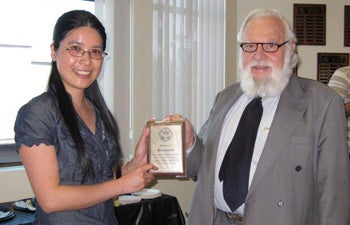A Talent for Math
Two USC Dornsife doctoral students have been awarded USC’s Center for Applied Mathematical Sciences (CAMS) Graduate Student Prize for Excellence in Research for their contributions to the fields of mathematics and physics.
Yang Huang of mathematics and Wan-Jung Kuo of physics were selected among 13 nominees across USC schools and departments including molecular and computational biology, computer science, physics, linguistics and mathematics.
The CAMS Prize was initiated in 2010 to highlight the quality and significance of student research with a substantial mathematical component. Currently the awards are partially funded from several donations including one by USC Dornsife Professor Emeritus of Mathematics Edward Blum.
Selected by the CAMS Board of Directors, each recipient was honored with a plaque and $1,000 on April 17 during a ceremony hosted by CAMS, housed in USC Dornsife’s Department of Mathematics.
“The nominations we had were all remarkably strong candidates,” said Susan Friedlander, professor of mathematics and CAMS director. “We believe it’s important to recognize the work of really excellent graduate students.”

Kuo of physics poses with Solomon Golomb, University Professor and Distinguished Professor of Electrical Engineering, holder of the Andrew and Erna Viterbi Chair in Communications. He is also a member of the CAMS Graduate Student Prize for Excellence in Research Selection Committee. Photo by Fatima Perez.
Since his arrival to USC from China in 2007, Huang has worked with Ko Honda, professor of mathematics in USC Dornsife. He conducts research in 3-dimensional contact topology and Heegaard Floer homology, both of which are sophisticated tools used to analyze knots and 3-dimensional spaces. Huang’s findings may provide a better understanding of knotting phenomena in fields such as quantum computing and molecular biology.
“As topologists we want to find a mathematical way to understand different shapes,” Huang said.
Huang’s research has added to Eliashberg’s seminar paper “Classification of Overtwisted Contact Structures on 3-manifolds” from 1989 and has helped improve the understanding of homology theories such as Heegaard Floer homology.
“Yang has made substantial progress toward understanding and clarifying certain aspects of contact structures in 3-dimensional spaces,” Honda said.
After obtaining his Ph.D. in mathematics in May 2012, Huang will continue his research at the Max Planck Institute for Mathematics in Bonn, Germany.
Kuo has been conducting research with Daniel Lidar, professor of chemistry in USC Dornsife with a joint appointment in USC Viterbi School of Engineering, to find analytical proofs and performance bounds for protocols in quantum information processing.

Golomb congratulates Huang of mathematics at the CAMS Graduate Student Prize for Excellence in Research award ceremony. Photo by Fatima Perez.
She has worked with Lidar, who serves as the scientific and technical director of the USC-Lockheed Martin Quantum Computing Center, to find optimal interpolation paths for adiabatic quantum computation in a differential-geometric framework. Additionally, Kuo has focused on optimal quantum control. Her work has proved that the quadratic dynamical decoupling sequence performs the high decoupling of arbitrary, bounded environments.
“Wan bravely set out to solve this problem, and her ultimate success is a testimony to her brilliance and perseverance,” Lidar said. “The proof Wan found is a true tour de force of analytical and algebraic techniques.”
After earning her Ph.D. in May 2012, Kuo, a native of Taiwan, will continue her work at Ames Laboratory at Iowa State University.
“I’m really happy and honored to receive this award,” Kuo said.